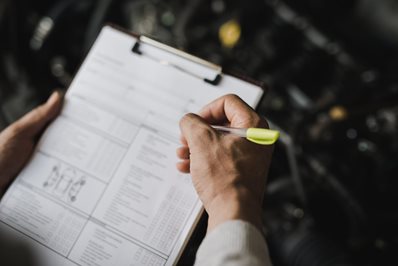Hydraulic Component Wear Causes
.jpg?width=398&height=266) Regardless of the hydraulic parts and components used in your hydraulic equipment, and the type of maintenance plan you follow, all hydraulic parts wear from normal wear and tear. As they start to wear, you may notice changes in system performance. By learning more about the different types of hydraulic component wear, you can adjust your maintenance plan to avoid hydraulic system failures.
Regardless of the hydraulic parts and components used in your hydraulic equipment, and the type of maintenance plan you follow, all hydraulic parts wear from normal wear and tear. As they start to wear, you may notice changes in system performance. By learning more about the different types of hydraulic component wear, you can adjust your maintenance plan to avoid hydraulic system failures.
Hydraulic System Failure Causes
The most common causes of hydraulic system failures are often related to hydraulic component wear and tear, such as:
- Poor Oil Quality
- Temperature/Heat Problems
- Air Leaks
- Water in the Oil
- Improper System Usage
- Low Fluid Levels
As a result, once you are more familiar with the different types of wear, you can take the necessary steps to reduce the likelihood of system failures.
Types of Wear
Cavitation
Cavitation wear occurs when air dissolved in the hydraulic fluid is drawn our of the fluid when a vacuum is created. When the pump volume is greater than the available fluid flow the negative pressure effect on the fluid will cause the dissolved air to be released from the fluid. The air bubbles form and grow on the insides of the pump body. The bubble grows until it bursts and the burst will cause erosion to the surface of the inside of the body at that point
Abrasive Wear
Abrasive wear is when metal or other components rub against each other whilst lacking the proper lubrication. Depending on your system configuration, you could experience two-body or three-body abrasive wear.
Two-body wear is when two surfaces that are normally lubricated contact one another without any lubrication. Three-body wear is when two lubricated surfaces come into contact with a third surface that is not lubricated.
In addition, abrasive wear can occur when contaminants, such as metal shavings and flakes, are flowing through the system. This can result in three-body wear and scoring of metal surfaces.
Fatigue Wear
Fatigue wear is a normal wear and tear condition that occurs in hydraulic systems. It usually occurs in pumps and motors where there are bearings and gears. The moving parts can gradually crack and fracture until they eventually break off and enter the system—at which point, they can cause further damage and system failure.
This type of wear can also occur from point loading and shock loading resulting in higher stresses on the parts. Therefore, to reduce fatigue wear, it is important to avoid point loading and shock loading when it is unnecessary to perform the desired output.
Adhesive Wear
Adhesive wear is the result of continued abrasive wear, where the metal surfaces begin to generate heat due to the friction created as the parts rub together. As heat builds, it causes friction welding of the pieces.
As a result, the pieces will continue to pull apart and re-weld themselves together. As they do, metal flakes and shavings can be released into the system. Furthermore, complete seizures can occur in certain situations, and the parts will no longer pull apart.
Erosive Wear
Erosive wear occurs when hard particles of less than two microns are introduced into the system. As they move round the circuit they form a sort of paste that erodes any surfaces it comes in contact with. Eventually, the wear can increase clearance spaces and therefore leakage paths in between components.
Corrosive Wear
Corrosive wear is when a chemical reaction on metal surfaces results in a material loss. The most common type of corrosion is rust. While rust can occur on the exterior of hydraulic systems, it is not the most common cause of interior corrosion.
Hydraulic component wear inside the system is often caused by acids found in hydraulic oil. As oil degrades or if water is introduced into the system, it can create acids that will slowly degrade interior parts and components, especially if the system is left idle for a long period of time.
Preventative Care

The best preventative regime to prevent
hydraulic parts wear is to perform frequent hydraulic oil and filter changes. For example, abrasive wear, adhesive wear, erosive wear, and corrosive wear can all be reduced by ensuring the fluid is changed regularly—not allowed to degrade.
You should also inspect and test the fluid to determine if it has metal particles and water in it. If you notice metal particles, you must determine the source and repair or replace the affected parts and components.
Additionally, you should be able to easily identify when there is cavitation occurring .
With fatigue wear, even though it cannot be prevented or avoided, your maintenance plan should include replacing and / or servicing hydraulic pumps, motors, and other components that have bearings and gears based on their useful operating hours lifespan.
Most importantly, it is essential to remember that even with the most proactive preventative maintenance plan, hydraulic components will still experience wear and tear. Therefore, your goal should be to alter your maintenance plan to minimise and reduce the effects of wear and tear.
Hydraulic Repair Services and Replacement Parts
When you need to repair or replace hydraulic parts and components from normal wear and tear or complete system failures, you can rely on White House Products, Ltd. Our warehouse is stocked with an extensive range of hydraulic pumps, motors, cylinders, and other components.
We can also custom-build parts to your specifications. For further information about our repair services and replacement parts, please feel free to browse our website or contact us directly at +44 (0) 1475 742500 today.
Back to blog posts